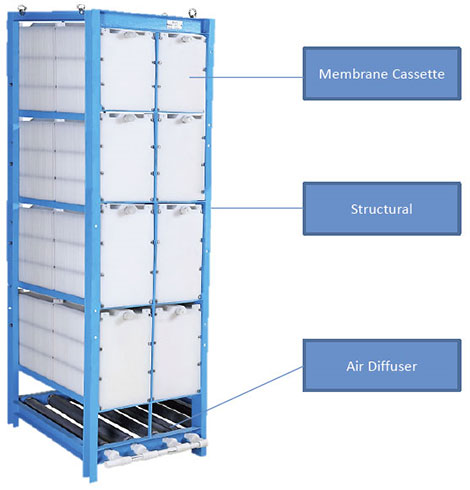MBR - Envirocube Submerged Ultrafiltration
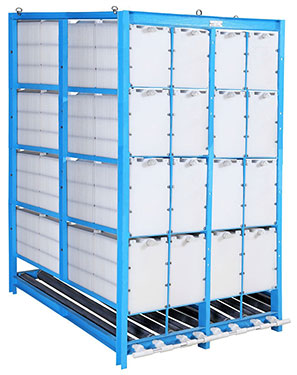
| Envirocube Module Specifications |
 |
 |
 |
||
| Envirocube Model | Unit | E8C | E16C | E32C | |
| # of Membrane Cartridges | 8 | 16 | 32 | ||
| Total Membrane Area | m2 (ft2) | 80 (861) | 160 (1722) | 320 (3444) | |
| Membrane Material | PVDF | ||||
| Flow Path | Outside – In | ||||
| Surface Property | Non Ionic / Hydrophilic | ||||
| Product Flow | m3 / day (gfd) | 38.4 (10144) | 76.8 (20288) | 153.6 (40576) | |
| Dimensions | Width | mm (in) | 520 (20.47) | 680 (26.77) | 990 (38.97) |
| Length | mm (in) | 660 (25.48) | 990 (38.97) | 1262 (49.68) | |
| Height | mm (in) | 2315 (91.14) | 2315 (91.14) | 2315 (91.14) | |
| Module Weight (Dry) | kg (lbs) | 306 (675) | 532 (1173) | 979 (2159) | |
| Accessories Material | Outer Frame | MS with RFP resin coating / Option SS | |||
| Permeate header | PVC | ||||
| Air diffuser | EPDM | ||||
MBR Technology Advantages
Membrane Bioreactor (MBR) is a combination of a membrane process such as microfiltration or ultrafiltration with the activated sludge process, which result in achieving significantly low organic constituents in treated wastewater. The membrane bioreactor technology has gained wide acceptance as new technology for wastewater treatment systems. MBR has many advantages like superior product water quality and a smaller space required for installation and easier operation compared to activated sludge process (ASP). The sludge yield in MBR process is very low. The quality of effluent in MBR is superior to conventional ASP effluent. The effluent from MBR can be reused for industrial applications after RO (Reverse Osmosis) Treatment. MBRs can operate at much higher MLSS (Mixed Liquor Suspended Solids) compared to conventional ASP, resulting in a faster biological reaction and high organic load decomposition in a shorter time or in smaller space. Additionally, as an MBR system operates at a higher MLSS, the sludge yield is quite low, which results in saving in operational cost of the system.
Envirocube Ultrafiltration Module
Envirocube has been developed after years of research and development that has resulted in an ultrafiltration membrane with uniform pore size and high rejection capacity. Envirocube modules consist of flat sheet PVDF ultrafiltration membrane cassettes, air diffusers and a product water manifold.
Air scouring is provided by the diffusers installed at the bottom of the module which continuously scrubs the membrane surface. A reverse diffusion process takes place at regular intervals by gravity flow of product water from an overhead backwash tank. Also, a cross flow of effluent is provided over the membrane surface. These characteristics result in lower transmembrane pressure and production of consistent water quality on continuous basis.
The compact modular design provides the benefit of a higher membrane surface area and ease of membrane cartridge removal during assembly or replacement.
Envirocube Product Description
Membrane material
PVDF is used as a base material for flat sheet membrane because of its outstanding oxidative, thermal and hydrolytic stability as well as good mechanical and film-forming properties. The Envirocube membrane has polypropylene fabric as base which helps in producing consistent product quality. Repeated test results for clean water flux during MBR operation has shown very good suspended solid rejection, constant flux values and response for physical/ chemical cleaning.
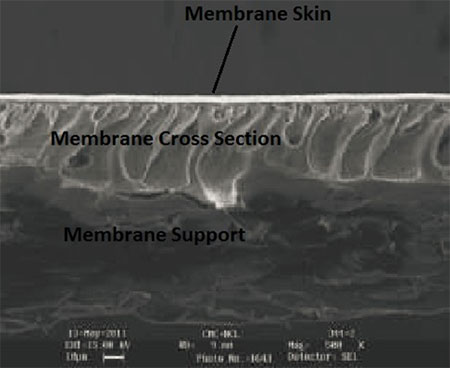
Filtration principle of flat membrane in submerged MBR
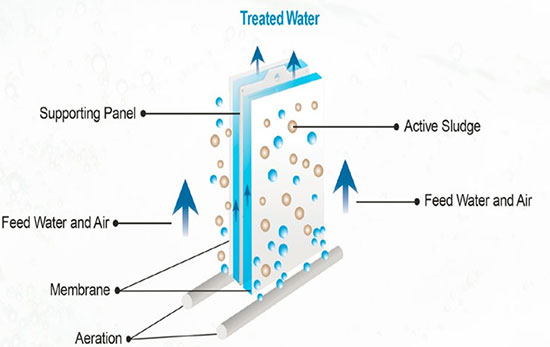
Membrane Plate
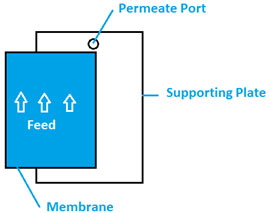
| Shape | Flat plate | |
| Construction | Supported | |
| Configuration | Submerged | |
| Size & Weight (ME plate) | Membrane Pore size (micron m) |
0.04 |
| Membrane Area (m2) | 0.182 | |
| Width (mm) | 290 | |
| Height (mm) | 465 | |
| Thickness (mm) | 3.8 | |
| Weight (kg) | 0.33 (dry) | |
| Material | Membrane | PVDF+ PP Non-woven |
| Frame | PP | |
| Sealing type | Welding | |
| Operating Conditions |
Temperature (C) | 15 – 40 |
| Max Trans-membrane Pressure (kilopascal) |
50 | |
| pH | 2 – 10 | |
| Air Scouring (L/m2/hr) | 250-800 | |
Membrane Cartridge
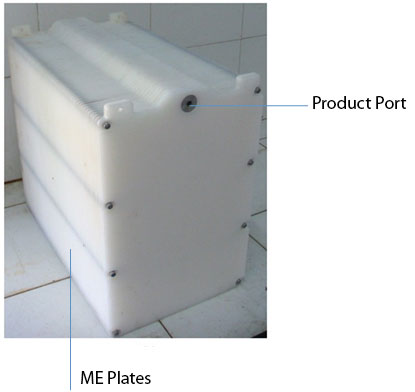
Membrane Module
